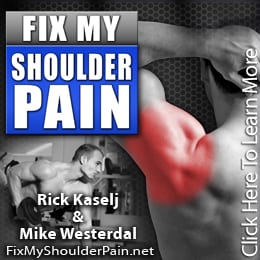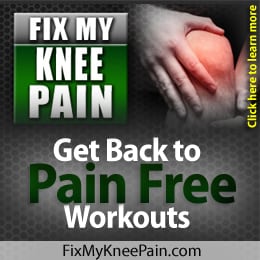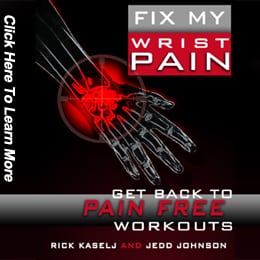Shoulder Pain Relief Through Exercise with Rick Kaselj
Shoulder Pain Relief Through Exercise with Rick Kaselj – Part 1
Jesse Cannone: Hello everyone, welcome. My name is Jesse Cannone and this is the Live Pain Free Audio Interview Series. Today I’m going to be talking to my friend Rick. How do you pronounce the last name again, Rick? I don’t want to butcher it.
Rick Kaselj: Kaselj.
Jesse: Kaselj. I apologize, I’ve screwed it up so many times, I had to ask for help.
Rick: No worries.
Jesse: So we’re going to be talking today about shoulder problems. Shoulder issues seem to be very common, just like knee and back pain, so what I’d like to do is talk a little bit about the most common shoulder issues that people experience. What causes them, how do you treat them, what’s the most effective way of getting rid of those shoulder problems, maybe exercises that people should be doing, exercises that people should be avoiding, and so on. Before we jump into that, can you give everybody a brief background? How did you get to where you are today?
Rick: OK. My name is Rick Kaselj and I’m a personal trainer up in Vancouver, Canada, and I specialize in designing exercise programs for people with injuries. That whole passion started a number of years back when I was going through school and I wanted to become a physical therapist. I worked in a variety of physical therapy clinics just helping out, and what I found out was I really liked the injury side of things and the exercise side of things, but I didn’t like a lot of the other stuff that physical therapists did.
I ended up focusing on the exercise and injury side of things, and helping the physical therapists and other healthcare professionals. A lot of times, doctors and chiropractors and physical therapists will have clients and they will have done some work with them, but now it’s time for them to continue on with an exercise program. I help them with their clients, after they’re done with them, on designing an exercise program to fully help them overcome their injuries.
I’ve been doing that for about the last 14 years, focusing in on that, and I really have a passion when it comes to the shoulder. I have a strong interest in the shoulder and went back to school and got more knowledge and information when it came to the rotator cuff. So now I pretty much just see clients that have knee, back, shoulder injuries, and help design an exercise program that works for them that they can do in the gym, in the recreation center, or even at home.
Jesse: Great. Cool. And I am sure you’ve probably experienced this in all the years that you’ve been doing it, and that is that the exercise program that you create is, I imagine, oftentimes much more effective than the treatment that they’re getting from the physical therapist or the doctors that they’re working with before they come to see you.
Rick: I would say, “Yes.”
Jesse: It’s OK to say yes.
Rick: I mean I find the exercises a key component. A lot of times with other health care professionals they might provide an accurate diagnosis. They might do some treatment when it comes to inflammation and improving the movement of certain joints. But after that, what’s needed is, you need to increase the strength of that joint. You need to work on the range of motion of that joint. You need to work on the stability of that joint. And a lot of times, it’s not really practical to be doing that in the clinical setting. You can’t keep going to the doctor’s office and the physical therapy clinic all the time. It’s not really realistic. We need to kind of figure out what we can do at home, or in the recreation center, or in the gym that we go to. That can kind of help overcome that injury and prevent that injury from ever coming back.
Jesse: Right, and I like to put it like this. The injury came about in large part due to the way you live your life. I don’t want to really say lifestyle because that sounds like, “Oh! I am a beach bum.” I don’t really mean lifestyle in that sense, but more like, “How you live your life ‑ what activities you do, how active you are.” Because lot of people think that because they’re active, that’s a good thing. But they don’t realize that oftentimes the activities that they are doing are creating or worsening existing injuries.
Rick: Very true!
Jesse: Well, let’s get started for the topic. What would you say are the most common problems people experience with the shoulder?
Rick: I may think number one tends to be rotator cuff injury. Number two would be some sort of shoulder impingement. And then number three would be some sort of shoulder instability, so too much movement in the shoulder joint. Those would be the top three that I would end up seeing.
Jesse: OK, so let’s start with the first one then ‑ rotator cuff issue. Can you describe briefly what is the rotator cuff for the person who is listening? Maybe they’ve heard that terminology before, but they don’t know what that means.
Rick: OK. So, we look at the shoulder joint. There are three groups of muscle that end up helping out. There is the superficial muscles. The muscles that we can see if we look at our shoulder from the front, side and back, we feel those larger muscle groups that are helping move the shoulder. Those muscles very rarely tend to get injured or weak. Now the second group of muscles is a lot deeper and closer to the joint and those are the rotator cuff muscles. Their primary role in a really simplistic sense is to keep that shoulder joint together. They turn on and they kind of pull that shoulder joint together to hold it nice and tight while you are doing your movements.
And then the third muscle group, which is often overlooked and I find is the key to overcoming a lot of shoulder injuries, is the scapula stabilization muscles. All the muscles around the scapula because what the scapula ends up doing, it ends up moving when you move your arm in order to give you more range of motion.
If we look at the rotator cuff, what often happens is the muscles that we can see around our shoulder they are usually not the problem. It’s usually the rotator cuff’s the problem. When we use our arms a lot, a lot of times the rotator cuff can be overworked. So for example, if we are in a poor posture for a long period of time like from driving for a long period of time or sitting at the computer for a long period of time, that doesn’t put our shoulder in a nice position.
And with it not being in that good position, it puts a fair bit of strain on the rotator cuff. So some people injure that rotator cuff from some sort of fall or hit, but a lot of times it’s kind of gradual in nature. More and more strain gets put on that rotator cuff and eventually it can’t take it anymore, so you end up having pain. And it ends up affecting the things that you enjoy doing.
It affects every movement that you do when it comes to your shoulder. And a lot of times what people will report is, if you put your hand on your shoulder and you kind of put press on it, especially on the outer part of the shoulder, they’ll feel it being sensitive or sore. And a lot of times, that’s a good sign that you’ve injured your rotator cuff.



